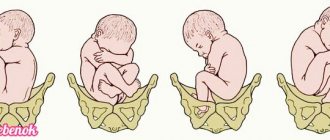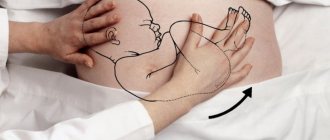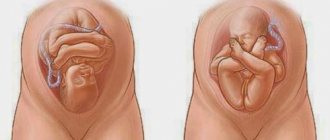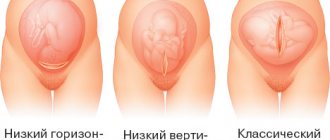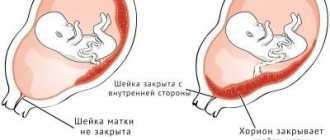Throughout pregnancy, the baby turns over in the mother’s stomach, but in the 3rd trimester it grows especially intensively, and the possibilities for changing position become less and less. In the period from 33 to 37 weeks, it turns head down - towards the exit of the uterus. This presentation is considered correct and is called cephalic. But for some reason, the baby may be positioned with his butt and legs down. This feature causes concern for mothers: childbirth with a breech presentation does not occur quite normally; it requires experience from a doctor and obstetrician, and sometimes surgical intervention.
Incorrect positioning of the baby towards the end of pregnancy can be caused by various reasons. The decision on the method of delivery is made by the doctor and the expectant mother together, after discussing all possible complications during and after the process.
What kind of pathology
In the first 30 weeks of development, the baby moves freely in the mother's belly. This is not surprising - there is a lot of liquid around, which is easy to move around. Its dimensions are still small and nothing interferes with movement.
After 32 weeks, he becomes cramped, and he assumes a position in which he will most likely lie until birth. For mom, any position of the baby does not cause any discomfort.
It is determined by ultrasound. In 90% of cases, the child lies head down - this is the most favorable position for natural childbirth and the baby takes it reflexively.
But sometimes the child is positioned with his legs or bottom forward. This position is called breech presentation of the fetus.
There may be several reasons:
- premature pregnancy, then the embryo is still too small and moves freely in the mother’s belly;
- underdevelopment of the baby’s vestibular apparatus, which is why he does not take a head-down position;
- polyhydramnios, in water the child cannot fixate in one position, or, on the contrary, oligohydramnios, then the child is almost motionless;
- restriction of the child’s mobility by growths on the walls of the uterus or the physiological characteristics of the woman.
With repeated deliveries, a woman may experience decreased tone of the uterus and abdominal wall. If it is too high, the child is limited in mobility and cannot take the correct position.
Positioning your feet or buttocks forward is unfavorable for natural childbearing, but does not exclude it.
First of all, there are several types of violation.
- Gluteal. It is the most common and most favorable for a woman in labor. The child seems to be squatting, or if the fetus is lying bottom down.
- Foot. The baby's feet are at the entrance to the uterus.
- Mixed.
Why is breech presentation formed?
Breech presentation occurs in approximately 10% of pregnant women.
The risk group includes the following cases:
- Polyhydramnios, premature or multiple pregnancies are complications in which the child remains quite mobile until birth.
- Anatomically narrow pelvis in a woman.
- Low location of the placenta when it is in the way of the baby moving along the birth canal.
- Abnormally large size of the fetal head.
- Oligohydramnios, abnormalities in the structure of the uterus (bicornuate, saddle-shaped, with a septum).
- Low tone of the uterus, when its walls do not respond properly to irritation and do not correct the position of the fetus.
- Uterine fibroids or ovarian tumors that prevent the correct positioning of the head.
- Pathological hypertonicity of the lower sections of the uterus due to curettage, frequent childbirth, endometritis, cerivitis - a condition in which the child’s head tends to occupy the less spasmodic upper section.
- Hereditary factor: breech presentation occurs more often in women who also had their buttocks forward at birth.
When should you go to hospital?
Breech presentation of the fetus is determined only at the third planned ultrasound, which is performed at 32-34 weeks of gestation. The woman in labor is prescribed special exercises, and it is recommended to visit the pool.
If the baby does not change its position, then a week or two before the expected date the mother is hospitalized and a council of doctors decides whether it is safe for the woman to give birth on her own or whether a cesarean section is necessary.
How does childbirth occur with breech presentation in Russia?
The hardest test is to lie on one side (the one where the baby's back is located) during contractions. Doctors are afraid of premature rupture of amniotic fluid, hypoxia and asphyxia, loss of limbs or umbilical cord, infections and other anomalies of labor.
From the moment the pushing begins, the woman is injected with oxytocin. In case the contractions weaken, and we remember that the baby's head should be born quickly. At the moment of eruption of the buttocks, to alleviate further “suffering”, the mother is cut into the perineum. All this time, from the moment contractions begin, the condition of the child and the strength of uterine contractions are monitored using CTG devices. In any case, at the moment of birth itself, after each attempt, doctors check the baby’s heart.
The third stage of labor, that is, the birth of the placenta, most often does not differ in any way from ordinary natural childbirth.
External turn
It is carried out in a hospital setting, not earlier than 36 weeks. This will help avoid surgery. The doctor can turn the baby mechanically in the mother's belly, using pressure on the butt and head.
This procedure has many contraindications and is performed only in a hospital setting.
In case of any complaints from the mother, the procedure is stopped. There is also a risk of premature birth.
If the procedure is successfully completed, the woman is advised to wear a special bandage until the baby is born to eliminate the risk of reverse rotation.
Maternal health status and gestational age
Here, doctors assess the woman’s age (respectively, very young and very “aged” score the least points on the doctor’s scale), obstetric history (that is, the course of past pregnancies and births, as well as the course of this pregnancy), the body’s readiness for childbirth (the state of the amniotic sac and cervical maturity) and pelvic dimensions. The size of the pelvis is assessed externally, but the woman is strongly recommended to undergo an X-ray pelviometry procedure.
The duration of pregnancy is also an important factor. If the baby is premature (up to 37-38 weeks), then his head is most likely noticeably larger in size than his body, and therefore there is a risk that it will get “stuck.”
Thus, if you are a woman from 20-30 years old with an ideal pregnancy with a child in a purely breech presentation with a wide pelvis for a period of 37 weeks or more and experience of successful childbirth behind you, you may be allowed to give birth vaginally.
Indications for ER
The violation is unfavorable for the traditional resolution method. The baby goes through a very difficult path with several turns at birth. The first to emerge are the baby’s buttocks, which are smaller than the head, and subsequently the head compresses the umbilical cord.
A council of doctors may decide not to perform a caesarean section for a breech fetus; there are a number of reasons for this:
- The mother’s health is not a cause for concern among the doctors - she had no unsuccessful births, no damage to the uterus, and her physical health is in perfect order;
- young age of the woman in labor - up to 35 years at the first birth;
- full-term pregnancy, when the embryo is underdeveloped - its head is too large in relation to the body and complications are possible during childbirth.
Traditional pregnancy resolution is only possible for girls. Boys run the risk of damaging their scrotum when they are born.
Actually presentation
There are several types of breech presentations:
- gluteal, when the buttocks are present at the entrance to the pelvis;
- mixed gluteal, in which the feet of both or one leg are “presented” next to the buttocks;
- foot, in which the child “rests” on the mother’s pelvis with his legs;
- knee - this is a type of leg, when the baby seems to be standing on his knees.
The most popular and safest, from the point of view of doctors, is breech presentation. The knee, in turn, is considered the rarest.
The fact is that with a breech presentation, the child’s straight legs with raised feet are bent at the hip joints and pressed against the body. The baby is shaped like a “cone”, the widest point of which is the shoulders. That is why the head is born after them without problems. With a mixed breech presentation, the buttocks together with the legs expand the birth canal more and also contribute to the unhindered birth of the head.
Doctors “allow” women with a purely breech presentation to give birth, since in all other cases complications are possible due to the incorrect placement of parts of the child’s body. The most important thing is that the baby's head is born within five to ten minutes following the shoulders. Otherwise, he is at risk of hypoxia, since the umbilical cord is most often compressed by this very head. In addition, the baby’s head may fall back, which can lead to injuries to the cervical spinal cord, cerebellum and other birth injuries. The baby's arms may be stretched upward and also inhibit the birth of the head.
Possible complications during labor
After deciding on natural resolution, the mother receives instructions from specialists.
These include:
- special gymnastics;
- restorative drugs;
- psychological preparation for childbirth.
In the absence of competent actions by the obstetrician, both the newborn and the mother can receive injuries of varying severity. These may be ruptures, neurological and mechanical injuries in the newborn, hypoxia.
Features of the birth process with breech presentation of the fetus
The doctor will decide whether to give birth by cesarean section, or to help the woman give birth herself, based on some indications:
- Age of the woman in labor. In Russia, a woman after 35 is considered old-timer, therefore, if the woman in labor has already reached her 35th birthday, then if the baby is breech, she will be operated on.
- The structure of the pelvic organs. If a woman has a very narrow pelvis, then even if the baby is in a normal position, such women in labor will have a Caesarean section.
- Features of pregnancy. If carrying a child for 9 months was complicated by late toxicosis, gestosis, fetal hypoxia, then if the child is in the pelvic position in the womb, such women in labor are prepared for a cesarean section.
- Baby sizes. If the birth of a fairly large fetus is expected, more than 3.5 kg, then a cesarean section is indicated.
- Type of pelvic position. If there is the rarest type of breech presentation - foot presentation, then surgical intervention during childbirth is clearly indicated.
In case of breech presentation, the doctor decides whether the birth will be natural or whether a caesarean section should be resorted to.
Childbirth with breech presentation must be carried out taking into account all the features of the course of pregnancy and the condition of the woman in labor and the fetus.
When should a cesarean section be performed?
The absolute indications for a cesarean section for a breech baby are:
There are a number of indications for which a caesarean section is indispensable
- The woman is over 35 years old.
- Primipara over 30 years old.
- Chronic diseases of the heart, kidneys and other organs.
- Complications during pregnancy.
- Expecting a male child, since with a breech presentation there is a risk of scrotum compression.
- Previous births by cesarean.
- The fetus is positioned with its feet towards the exit from the womb.
- Anomalies of the pelvic organs.
- The child has been diagnosed with umbilical cord entanglement or hypoxia.
- A very premature baby, or vice versa, has a large body weight.
Approximately 80% of births with a pelvic position are carried out through surgical intervention, since there is a high probability of various types of complications.
When can you give birth naturally?
Although a caesarean section is performed in most breech cases, there are situations where a woman can give birth on her own.
This depends on the following factors:
- If the woman is healthy and there were no complications during pregnancy, then a natural birth with a breech presentation may well be carried out.
- There is a singleton pregnancy, and the fetus does not exceed 3500 g.
- The fetus is completely adjacent to the buttocks at the exit of the uterus.
- The pelvic organs have a normal structure and there are no pathologies in them.
With a breech presentation, a natural birth is possible.
If a woman is admitted to a maternity hospital, where there is the necessary equipment for conducting a natural birth with a breech presentation, and qualified specialists work, then she will definitely be helped to avoid serious complications.
Features of labor management
The process takes longer and is more difficult than when being born head first. It goes well for the mother and child with the competent work of specialists and the right tactics.
During labor
During natural breech birth, anesthesia is usually used, most often an epidural. It makes this period easier.
The mechanism of labor in breech presentation involves a slower and longer dilatation of the cervix. More often, premature rupture of amniotic fluid is observed, so the woman in labor lies on her side during childbirth. This allows you to keep the amniotic sac intact for as long as possible.
The bubble of water protects the baby from damage, has a directed effect on the mother’s bones and pressure forces them to diverge wider. It is correct to lie on the side on which the child’s back is located.
Throughout the entire process, the condition of the mother and child is monitored using CTG and in case of any complications or risks, the doctor may decide to perform an operation.
In progress
During contractions, it is no longer possible to carry out a CS, so this period is the most critical and requires maximum attention from the medical staff.
Childbirth is performed lying on your back with legs bent. The process is monitored using CTG and drug therapy is required, drugs are administered that enhance uterine contractions.
The doctor monitors the baby’s every movement to prevent complications and injuries. An episiotomy is often necessary to relieve injuries.
After
In the postpartum period, both mother and child require special attention. The newborn should be monitored by neonatologists, as he is at risk for developing complications.
The mother often experiences trauma, such as a cervical rupture, that requires suturing. Bleeding often occurs, leading to urgent medical intervention.
What complications can there be?
Childbirth in which the fetus is in a breech position is more often accompanied by complications.
The following situations are at highest risk:
- Weak labor and insufficient dilatation of the cervix. The baby's butt and legs are smaller than the head and do not put enough pressure on the lower part of the uterus, which is why it contracts poorly.
- Due to the fact that the legs and butt put uneven pressure on the lower part of the amniotic sac, premature rupture of amniotic fluid may occur, as well as prolapse of the umbilical cord and the baby’s legs.
- When passing through the birth canal, the baby's head may tilt back, which will complicate the birth process and may lead to injury.
- There is a high risk of developing hypoxia due to strangulation of the umbilical cord and impaired blood flow to the child.
- Natural breech birth of boys can result in scrotal injury.
- Serious injuries to the birth canal and fetus occur when there is difficulty in the passage of the shoulders and head. Traumatic brain injuries with hemorrhages are possible.
All these complications occur more often in premature babies. Their head is much larger than the body, which makes it difficult for it to pass through the birth canal.
Indications for CS
Natural childbirth with a breech presentation is allowed by the decision of a medical commission, if the mother and baby are healthy and the risk of complications during childbirth is minimal. In all other cases, the council directs the pregnant woman to have a caesarean section.
The reasons may be:
- premature or post-term pregnancy, including if the child weighs less than 2500 or more than 3500 grams;
- the age of the woman in labor is over 30-35 years;
- a history of complicated childbirth, including any damage to the uterus;
- mother's narrow pelvis;
- male gender of the baby;
- position of the baby with its legs down.
Such a violation is an uncommon occurrence during pregnancy. For breech births, a caesarean section is prescribed. It makes the birth of a child easier for the woman and reduces the risk of injury to the newborn and his mother.
Birth is quick and painless; most mothers' fears are not justified.
Anna
I gave birth to a mixed breech baby boy myself on January 24th. I'm so happy that everything worked out.
I wanted to go through everything myself to the end, to actively participate in the process of giving birth to a baby, when you go through pain and receive a reward for it - your child. Last New Year I made a wish - to get pregnant, and this year - to give birth to the healthiest baby. He had been in this position since the 30th week and no longer rolled over, despite the exercises. The word CS made me hysterical and, after searching through all the articles on the Internet, I began to look for a doctor in my large city. I was told that only a CS, and urgently. Having decided that the CS would be performed in any city, she left for a small town where her husband’s parents live. There was a doctor with 30 years of experience who had delivered such births, especially before. The child is small, my pelvis is good, I myself am healthy and athletic, in general she agreed. But since there were also diagnoses of fetoplacental insufficiency and oligohydramnios, they decided to induce labor. They put in kelp and gel, punctured the bladder and inserted a catheter to intensify contractions and add injections to improve the child’s blood flow. The contractions were strong, but I didn’t understand what pushing was. I started pushing for the contraction and then the doctors began to get angry that I was pushing incorrectly and thus nothing would work out. As a result, the birth itself took quite a long time, she pushed many times, then the two of them began to press on the stomach. The doctors were afraid for the head, but it just came out easily; the pelvis and torso took a long time to sink. The heartbeat was constantly monitored, but when he was born the doctor suddenly said: “You yourself heard that the heart was beating.” They grabbed the child and took a few steps and he first sneezed and then screamed. The doctors breathed a sigh of relief, then scolded me for my poor work, although I tried, and in the end they even pushed without contractions. The obstetrician said that they had often given birth this way before, but at the same time they pushed as hard as they could. The child was given all the tests and was told that everything was normal. But in my case it turned out to be too risky, although I was sure that everything would be fine, the obstetrician and the doctor were really very experienced and I believe that the child’s body is quite ready for such stress as childbirth, unless there are serious contraindications. The happiest moment was when I was lying on the birthing table and the baby was lying next to me under the lamp. In general, I believe that such childbirth is possible, provided there are experienced doctors and good training of the mother (you can learn to push even before pregnancy). But it’s better if they go on their own naturally. January 31, 2013
